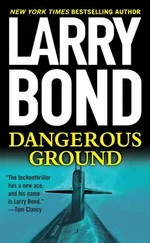“Don’t think so, Eng,” Jerry replied. “It’s in the right location for their emergency distress buoy.”
“Well, it doesn’t look like it went too far,” commented Shimko sarcastically. “Look at that line on the starboard sonar display. It comes out of the hull and then snakes off towards the southwest on the ocean floor. The buoy probably never made it to the surface.”
“Then it’s a fair bet that the Russians don’t have clue as to where she is,” added Rudel, a grim tone in his voice. “Keep moving aft, Jeff.”
LaVerne resumed her slow trek down Severodvinsk. A short time later it came across the emergency escape hatch; closed but apparently in good condition. Then the hull tapered sharply near the stern, and the rudder and stern planes came into view.
“Migod.” Shimko’s reaction was automatic, unthinking. Jerry felt the same horror. The starboard side stern plane was crushed, a mass of tangled color on the display that didn’t reveal its exact shape, but confirmed its destruction. Had it struck the bottom? Or Seawolf?
The lower rudder was also crushed, but it was impossible to tell if that was from being dragged on the bottom or from the collision. They were so focused on the condition of the stern planes and rudder that Palmer was the first to notice. “The screw’s gone!”
“What? Have LaVerne get us a view from the starboard quarter,” Rudel instructed.
According to intelligence, Severodvinsk was fitted with a seven-bladed “scimitar” screw. Instead of the older four or five broad leaf-shaped blades, seven thinner blades, sharply curved and skewed, sliced through the turbulent wake with less vibration, which meant less noise. Modern Western and Russian subs both used highly skewed seven-bladed screws, or even more exotic ducted propulsors.
But the image showed no blades at all, just a flat round circle with an occasional ragged edge where the propeller should be.
Palmer sounded like he was protesting. “We didn’t see it on the bottom. It’s some twenty-odd feet in diameter. We should have seen it when LaVerne circled the boat.”
“If the screw is gone, it would mark the actual spot where we collided,” Shimko said confidently. “She must have struck us with her stern. Her screw would have chewed up our bow, but the shock would have broken the blades off the propeller hub.”
“They hit us at a fairly high speed,” Lavoie remembered. “Without the water resistance from the blades on the propeller shaft, the propulsion plant would have run wild. We know he was running at high speed. Imagine it— fifty thousand horsepower with nowhere to go. The turbines would have torn themselves apart before the overspeed safeties tripped.”
Jerry added, “The shaft seals would have failed, so you’ve got massive flooding. Even if…”
Shimko impatiently ended the discussion. “Okay guys, enough. This speculation is pointless. They’re down, and without propulsion they’re helpless. There’s no sign of working machinery, but the hull appears to be intact. Based on what we’ve seen, there may be survivors on board.” He said the last with a note of formality, as if making an official statement.
“I concur,” Rudel stated, and the other officers nodded their agreement as well. “One last thing before we phone home. We’ll try the Gertrude.” Rudel quickly headed for the ladder. Over his shoulder, he ordered the phone talker, “Tell the chief of the watch to have Petty Officer Sayers report to control immediately.” Sayers was one of the crypto techs assigned to provide intelligence support. He spoke fluent Russian.
Jerry and the other officers followed their captain. “Gertrude” was a nickname for their underwater communications system. Jerry was suddenly reluctant to use it. No response might indicate there was nobody alive, or they might be alive, but without power.
But what if they did answer?
Severodvinsk
Senior Seaman Fesak was cold, tired, and bored. He had been sitting for the last three hours listening on the MG-35 underwater communications station for any sign that someone was out there looking for him and his crew-mates. But all he had heard thus far was the same he had heard over the last several days — nothing but waves and ice. He stifled a yawn and wrapped himself more tightly with his blanket. In one more hour he would be relieved and then he could find someplace to take a nap. It was rather difficult to listen to wave noise for long periods of time without being lulled to sleep.
Suddenly, the young sonar technician was jolted out of his half-dozing state. He thought he had heard something. Adjusting the gain on the receiver, he sat motionless, listening intently.
“Severodvinsk, Severodvinsk. Do you hear me? Please respond.”
Fesak couldn’t believe his ears. The voice spoke clear Russian. The fleet had found them! Excitedly, he called out, “Captain-Lieutenant Rodionov! Someone is out there! They are calling us!”
Rodionov bolted from his chair and quickly made his way to the underwater communications station. “Let me hear,” he ordered.
Grabbing the headset, he put it on and listened. A moment later, a smile appeared on his face. Turning to Fesak, he said, “Find the Captain. Hurry, lad!” The seaman moved off as fast as he could, adrenaline temporarily relieving his fatigue.
Rodionov grabbed the microphone and set the system to transmit. Pushing down on the mike, he said, “Hello. This is Severodvinsk. It is good to hear you. Please identify yourself.”
The smile on his face melted away as fast as it appeared when he received the reply. “ Severodvinsk , this is the United States submarine Seawolf. You have been reported as missing and we are here to render assistance. We wish to speak with your Captain.”
Rodionov sat there stunned. An American, not the Northern Fleet, had found them. What was he supposed to do now? Where was the captain?
“Severodvinsk, this is Seawolf. Did you receive my last?”
Shocked out of his stupor, Rodionov reluctantly responded, “Yes, yes. I received your last transmission. I am waiting for my Captain. Please stand by.”
“Severodvinsk, Seawolf. Understood. Standing by.”
In less than a minute, Petrov, Kalinin, and most of the battle department commanders were in the central post, surrounding the underwater communications station. All were smiling, hope beaming from their faces.
“Have you responded to their hail, Anatoliy?” asked Petrov.
“Yes comrade Captain,” Rodionov replied nervously.
Puzzled by his junior officer’s answer, Petrov looked at him curiously and said, “Then what’s wrong?”
“Captain, it’s not the fleet. We have been found by an American submarine!”
“What!?!” exclaimed Petrov, alarmed. “You mean the one we collided with?”
“I don’t know, sir. They said they were the Seawolf , that we have been reported missing, and that they are here to render assistance.”
An unexplainable anger arose within Petrov as he wondered if this was the same boat that had had a hand in their disaster? If so, where had they been for the last three days? If they were truly here to help them, then why had it taken so long? And where the hell was the Northern Fleet? These questions only served to intensify his fury as he remembered the eighteen men he had lost.
Petrov struggled silently to maintain a professional demeanor, but his clenched jaw betrayed his true emotions. It didn’t matter if this was the same sub that had collided with them. Despite their circumstances, he could not bring himself to speak with an American, any American, right now.
“Captain,” Kalinin asserted softly. “We need to respond.”
Читать дальше












